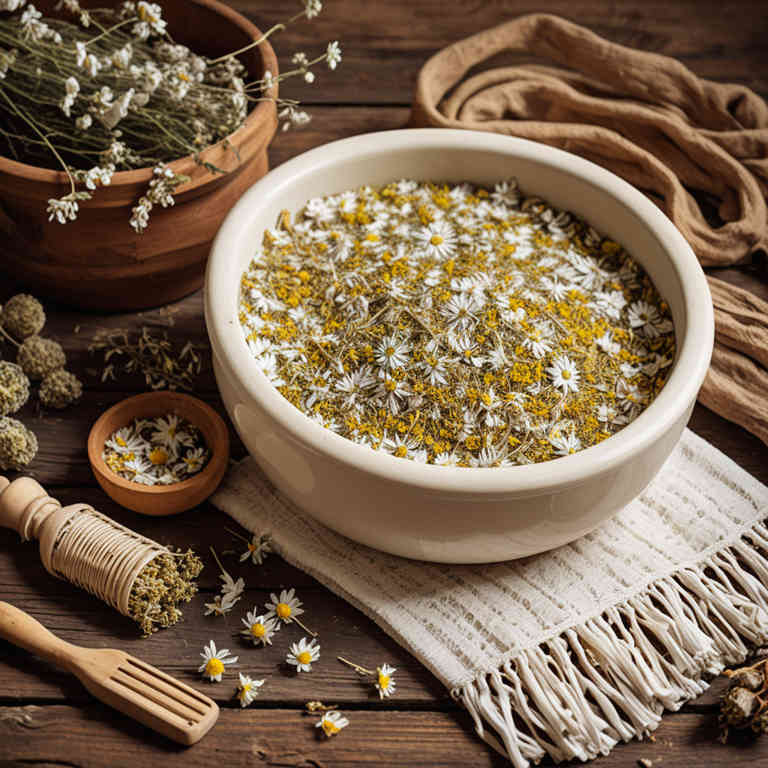10 Best Herbal Baths For Red Eyes

Herbal baths for red eyes involve using soothing plants known for their anti-inflammatory and antimicrobial properties to alleviate eye discomfort.
Common herbs such as chamomile, calendula, and eyebright are often used in these baths due to their ability to reduce irritation and promote healing. To prepare an herbal bath, steep a handful of dried herbs in boiling water for about 10-15 minutes, then allow the solution to cool to a comfortable temperature before using it as an eyewash. This natural remedy is particularly beneficial for those seeking gentle, non-invasive relief from redness and inflammation.
However, it is important to consult with a healthcare professional before using herbal remedies, especially if symptoms persist or worsen.
FREE Herb Drying Checklist
How to make sure every batch retains maximum flavor, color, and aroma without the risk of mold or over-drying. Eliminate guesswork and trial-and-error, making herb drying faster, easier, and more efficient every time.
Table of Contents
1. Hypericum perforatum

Hypericum perforatum, commonly known as St. John's Wort, has been traditionally used in herbal baths to alleviate symptoms of red eyes.
When infused into warm water, the bath can help reduce inflammation and soothe irritated eyes by leveraging the plant's anti-inflammatory and antiseptic properties. This natural remedy is believed to promote healing by improving circulation around the eyes and reducing oxidative stress. To prepare the bath, a handful of dried hypericum perforatum is steeped in hot water for several hours, then strained and used as a warm compress or added to a basin of warm water.
While generally safe, it is important to consult a healthcare provider before using this treatment, especially for individuals taking medications that may interact with St. John's Wort.
2. Matricaria chamomilla

Matricaria chamomilla, commonly known as chamomile, has been traditionally used in herbal baths to soothe and alleviate symptoms of red eyes.
The anti-inflammatory and antiseptic properties of chamomile can help reduce eye irritation, swelling, and infection when used in a warm infusion. To prepare a chamomile bath, steep a handful of dried chamomile flowers in boiling water for about 10 minutes, then allow the liquid to cool slightly before using it as a compress or gentle eye bath. This natural remedy is particularly beneficial for mild cases of conjunctivitis or eye strain, offering a calming and gentle alternative to conventional treatments.
However, it is important to consult a healthcare professional before using chamomile baths, especially if there are underlying eye conditions or allergies.
3. Equisetum arvense

Equisetum arvense, commonly known as field horsetail, has been traditionally used in herbal baths to alleviate symptoms of red eyes due to its high concentration of silica and anti-inflammatory properties.
When infused into warm water, the bath can help reduce eye irritation and swelling by promoting circulation and soothing inflamed tissues around the eyes. The astringent qualities of horsetail may also help tighten blood vessels, potentially reducing redness and discomfort. However, it is important to use caution and consult a healthcare professional before using such baths, especially if there are underlying eye conditions or infections.
While some anecdotal evidence supports its use, more scientific research is needed to fully validate its effectiveness for treating red eyes.
4. Urtica dioica

Urtica dioica, commonly known as stinging nettle, has been traditionally used in herbal remedies for its anti-inflammatory and soothing properties.
When prepared as a herbal bath, it can help alleviate symptoms of red eyes by reducing irritation and inflammation around the delicate eye area. To make the bath, fresh or dried stinging nettle leaves are steeped in warm water, creating a nutrient-rich solution that can be applied as a compress or used in a gentle bath. The high concentration of minerals like magnesium and silica in stinging nettle may support overall eye health and promote healing.
While generally safe, it is important to consult a healthcare professional before using any herbal remedy, especially for eye conditions, to ensure proper application and safety.
5. Achillea millefolium

Achillea millefolium, commonly known as yarrow, has been traditionally used in herbal baths for its soothing and anti-inflammatory properties, which may help alleviate symptoms of red eyes.
When infused into warm water, yarrow can provide a calming effect on the delicate eye area, reducing irritation and inflammation. The herb is believed to support the body's natural healing processes, potentially improving circulation and promoting eye health. To prepare a yarrow bath, steep a handful of dried yarrow in boiling water for 15-20 minutes, then allow it to cool before using as a compress or soaking the eyes.
While herbal baths may offer some relief, it is important to consult a healthcare professional for persistent or severe eye conditions.
6. Chamomilla recutita

Chamomilla recutita, commonly known as German chamomile, has been traditionally used for its calming and anti-inflammatory properties, making it a popular choice for herbal baths aimed at soothing red eyes.
When infused into bath water, chamomile releases compounds such as bisabolol and chamazulene, which may help reduce eye irritation and inflammation. A warm chamomile bath can promote relaxation and ease the strain associated with eye fatigue, offering a gentle, natural remedy for redness and discomfort. While it is not a substitute for medical treatment, it can complement conventional care by providing symptomatic relief.
To use, steep a handful of dried chamomile flowers in hot water for 10–15 minutes, then add the liquid to a warm bath and soak for 15–20 minutes.
7. Lavandula angustifolia

Lavandula angustifolia, commonly known as narrowleaf lavender, has been traditionally used in herbal baths for its calming and soothing properties.
When infused into bathwater, lavender can help reduce inflammation and irritation, making it beneficial for red eyes. The essential oils in lavender possess mild antiseptic and anti-inflammatory qualities that may support eye health when used externally. A warm lavender bath can promote relaxation and ease the strain associated with eye fatigue and redness.
While it is not a substitute for medical treatment, lavender baths may serve as a complementary remedy to support overall eye comfort.
8. Salvia officinalis

Salvia officinalis, commonly known as sage, has been traditionally used in herbal baths for its soothing and anti-inflammatory properties.
When infused into bath water, sage can help alleviate symptoms of red eyes by reducing inflammation and soothing irritated tissues. The antibacterial and antiseptic qualities of sage may also help prevent infections that can contribute to eye redness. To prepare a sage bath, simply steep dried sage leaves in hot water for several minutes before adding the infusion to a warm bath.
While herbal baths can provide comfort, they should not replace professional medical advice, especially for persistent or severe eye conditions.
9. Rosa canina

Rosa canina, also known as rosehip, is a herbal remedy that has been traditionally used for its anti-inflammatory and nourishing properties.
When incorporated into herbal baths, rosa canina can help soothe redness and irritation in the eyes by promoting circulation and reducing inflammation around the delicate eye area. The antioxidants and essential fatty acids found in rosehips support tissue repair and may enhance the overall health of the skin and mucous membranes. To use rosa canina for red eyes, it is recommended to steep a handful of dried rosehip berries in boiling water and then allow the liquid to cool before using it as a bath or compress.
While herbal baths can provide gentle relief, they should not replace professional medical advice, especially if symptoms persist or worsen.
10. Rosmarinus officinalis

Rosmarinus officinalis, commonly known as rosemary, has been traditionally used in herbal baths to alleviate symptoms of red eyes due to its anti-inflammatory and antioxidant properties.
When infused into bath water, rosemary can help soothe irritated eyes by reducing inflammation and promoting overall eye health. The aromatic compounds in rosemary may also have a calming effect, helping to relieve stress-related eye strain. To prepare a rosemary bath, simply steep fresh or dried rosemary leaves in hot water and add the infusion to a warm bath.
While not a substitute for medical treatment, this natural remedy can be a soothing complement to eye care routines.